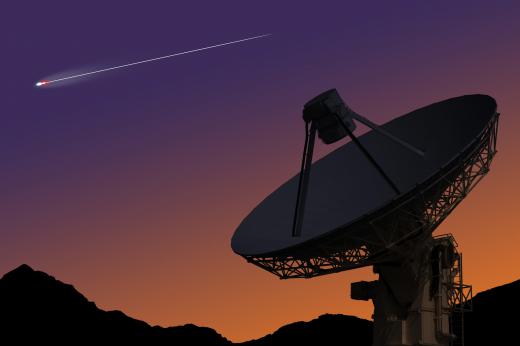What is Extraterrestrial Life?
 Tricia Christensen
Tricia Christensen
Extraterrestrial is defined as things located or that occur off of earth or not within the atmosphere of earth, while the term life is far more difficult to define. For the purposes of defining extraterrestrial life, it might be easiest to say, that life would be anything that is living, from single-celled organisms to multi-celled complex organisms (like plants or animals), that didn’t come from earth. Depending upon a person’s imaginations and theories, extraterrestrial life can conjure up the images of aliens with semi-humanoid features and with intelligence enough to eventually contact humans. Alternately, some people may view forms of life on other planets as mostly microbial in nature, and suggest that earth is the only planet where life in more complex forms evolved.
Despite the fact that scientists have not yet found true evidence of extraterrestrial life, there are some theories that we found and accidentally killed small microbes on Mars during the Viking 1 and 2 explorations in the 1970s. Evidence in the late 2000s of presence of methane gas in Mars’ atmosphere might also suggest some primitive life forms, but this gas can be created by geochemical reactions too. There is certainly much support in the scientific community for the idea that at the least, simple life forms exist on other planets, but less total support for the idea that complex forms of intelligent life exist, though this still fuels the imagination of science fiction writers and the general public.

There is much precedent for belief in extraterrestrial life. Several ancient Greek astronomers posited that there must be inhabitants on other planets. Expression that God created life on other worlds shows up in the Jewish Talmud, in the Qu’ran, and in many Hindu texts. As astronomy became more advanced, the ability to see the numerous planets that exist and the many stars through things like telescopes made it appear more likely that life had to exist on other planets, that earth could not possibly be unique as the only life-bearing planet in the galaxy or argued. This was argued from religious and scientific perspectives, though it was also argued from some religious perspectives that earth is the sole planet on which life exists.

One ambitious project that has searched for signs of extraterrestrial life is the SETI or Search for Extraterrestrial Intelligence program, which among other things, has sent signals via radio wave transmission, and continues to analyze radio wave signals as potential evidence of life off of earth. The program has not found definitive evidence of life elsewhere, but for the many who believe other planets have intelligent life, this may be only evidence that these life forms use other modes of transmission of signals. There also exists some concern about what is called active SETI (sending out messages), since it certainly can’t be assumed that extraterrestrial life would greet earthlings with open arms. Life elsewhere could be hostile and earthlings may be better off not alerting other life forms to their presence in the universe.

Carl Sagan stated, “The universe is not required to be in perfect harmony with human ambition.” This is perhaps one of the difficulties of searching for extraterrestrial life. Humans tend to see things through the lens and experience of being human, even with highly evolved scientific ideas, and people may not be able to imagine how dwellers of other planets would see things, evolve technologies, or communicate. People remain limited by being people, and it may be impossible to conceptualize how to find intelligent life, how to look for it, and whether it’s a good idea to search. Even the simplest single-celled organism poses potential threat to humans, since it did not evolve within the same structure as human, plant, and bacterial evolution on earth, and it is hard to know how such an organism would potentially interact with earth beings to maintain life; life tends to be aggressive in trying to remain alive.

However, the many planets in the universe, and even within this galaxy remain a sore temptation. They are an open invitation to search to find out if humans and other lifeforms on earth are truly alone in the universe. Is it all empty rock and barren nothingness, or do these planets teem with life and represent diversity in species and evolution like earth does?
AS FEATURED ON:
AS FEATURED ON:


















Discuss this Article
Post your comments